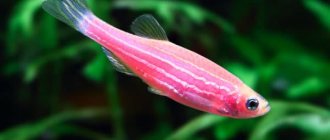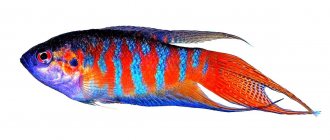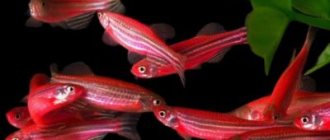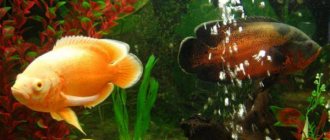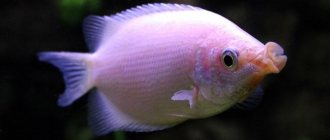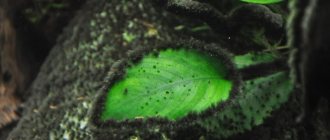In nature, zebrafish live in South Asia. They are very bright, graceful and nimble, therefore they are valued by aquarists. It is not difficult to breed zebrafish; they are unpretentious and can live in a small aquarium. There are some nuances regarding the reproduction of zebrafish at home, but if you study the features of the process in advance, then everything will be successful.
7 individuals can be kept in an aquarium
Species and biological features
In their natural environment, fish live in schools, so they should be kept in the aquarium in the amount of 6-8 pieces. Danios do not like stagnant water, so every week it is necessary to update 15% of the volume.
For maintenance you will need an aquarium with a volume of at least 10 liters, preferably an elongated one. Agile fish need a lot of space to swim.
As for food, any food is suitable. When spawning, fish prefer live food (for example, bloodworms).
The following types of fish are found in pet stores:
- zebra, or classic zebrafish – length no more than 7 cm, yellow and blue stripes on the body;
- pink zebrafish - a fish 6 cm in length, gets along with its neighbors in a common aquarium;
- firefly - body length does not exceed 3 cm, also called khopra;
- leopard zebrafish - the name of the species comes from the spots on the body, the maximum length of the fish is 5 cm;
- dangila – large species, length reaches 10 cm;
- orange-finned - this type of fish received its name due to the specific color of its fins (orange and yellow), grows up to 4 cm.
Care and maintenance
Keeping zebrafish is quite simple and even beginner aquarists can do it.
Despite their small size, the fish love to frolic and swim quickly, so they need a spacious aquarium. It is advisable to choose a rectangular container with a lid, since nimble fish sometimes jump out of the tank.
For normal life of veils, water must meet certain parameters, which are given in the table:
| Volume of water (liters per 1 individual) | Temperature (°C) | Acidity (pH) | Hardness (dGH) |
| 30 | 21-25 | 6.5-7.5 | 7-15 |
The bottom of the tank is sprinkled with small pebbles or river sand, making the soil thickness no more than 4-5 cm. The tank should be equipped with an aeration and filtration system, since zebrafish need clean water saturated with oxygen. A 20-30% water change is carried out weekly.
To create comfortable conditions, plants are planted:
- Vallisneria;
- hornwort;
- sagittaria.
But so that pets can move freely, greenery is placed near the back wall and on the sides.
The natural beauty of the fish becomes even brighter in bright light. To do this, fluorescent lamps are placed near the front wall of the aquarium. But pink pets also need natural light, so it is recommended to position the tank so that it is illuminated by sunlight for 2-3 hours throughout the day.
All the beauty of zebrafish is revealed only in a group!
Caring for pets includes proper feeding. Most of the veil diet consists of protein foods:
- bloodworm;
- Artemia;
- Daphnia.
To balance the diet, you should feed your pets with herbal supplements (steamed semolina, a slice of cucumber). For protein foods, beef heart is suitable. To ensure that the fish's diet is balanced and enriched with vitamins, ready-made dry mixtures are used, which are easy to purchase at any pet store.
To prevent the fish from overeating, they are fed 1-2 times a day. Overeating can lead to obesity and death of pets.
Reproduction in an aquarium at home
Zebrafish are considered sexually mature when they reach the age of 3 months. These fish are egg-laying fish; females lay many eggs, from which tiny fish are later born. Despite the fact that zebrafish spawning is a simple process, preparation for it is still required.
To bring the moment of reproduction closer, it is recommended to gradually increase the temperature of the water in the aquarium by 3-4 degrees.
We recommend reading
Pelvikachromis pulchera: compatibility and keeping parrot cichlids
It will not be superfluous to feed daphnia and fresh bloodworms. We must also not forget about regularly replacing the water in the tank.
After the above steps, zebrafish reproduction will not take long. Spawning can also be arranged in a community aquarium, but do not forget about your neighbors. For them, as well as for the parents themselves, the laid caviar will become a welcome snack. That is why it is so important to make a separate spawning area where the babies will be born.
Readiness of fish to reproduce
Before spawning, sexually mature individuals are placed in separate containers, where, at a water temperature of more than 20°C, they are actively fed with chopped tubifex, bloodworms and daphnia. It is easy to determine whether the female is ready to start spawning - after a few days, the female’s abdomen will become rounded.
Did you know? Danio is easily amenable to genetic modification, thanks to which varieties that do not exist in nature have been developed that fluoresce in the dark.
This is the signal for the start of reproduction. Typically, females give birth after males poke their abdomens.
When do fish spawn and how does it happen?
It is believed that in their natural environment, zebrafish reproduce mainly during the rainy season. At this time, fresh water is softest and warmest. In fact, rerio can spawn throughout the year. The secret lies in the conditions that are created for reproduction.
Before selecting a pair for spawning, you need to learn how to distinguish them. The abdomen of girls is more rounded, and the color looks brighter and clearer. The fish with caviar, ready for reproduction, are thick, with a large belly.
It is recommended to transplant the selected females and males into a separate prepared tank. Suitable water temperature is 27 degrees. The fish need to be moved in the evening. The couple is fed intensively, preferably with live food. Expectant mothers are given coretra. By feeding on it during spawning, they will not lose their shape and will subsequently produce healthy offspring.
If all conditions are met, then spawning can begin the next morning.
The spawning process takes no more than an hour. Both parents take part in it. He swims after her, as if urging her on, thereby helping to get rid of the eggs. The mother lays over two hundred eggs, then the father fertilizes them.
When the female's abdomen falls off, we can conclude that spawning is over. Now the couple is returned to the common aquarium so that it does not harm future offspring.
Matching
In order to obtain full-fledged zebrafish offspring at home, you need, first of all, to assess the condition of the existing “stock”. We must assume that one female needs the attention of two males. If you don’t have enough fish of your own, you need to buy some. And here novice aquarium fish lovers are faced with the question: how to determine the sex of a zebrafish?
Sexual dimorphism
Young individuals of both sexes look almost the same: they have slender elongated bodies, short tails, and fins. By the time of maturation, and this is the age from 6 to 8 months, the differences become more obvious. You should focus on these external signs.
The female is much larger than the sophisticated bright male.
Females are ahead of their peers in size, their abdomen is rounded. Compared to them, gentlemen look more modest - smaller in size. But in terms of attire, males give their young ladies a head start: the color of the skin becomes brighter, and the horizontal stripes look more contrasting. Females pale in comparison to males. There is also a difference in the shape of the anal fin. In female zebrafish it is rounded, in males it is pointed.
If you have the opportunity to observe the fish for some time, you can notice a difference in their behavior. The movements of females, especially pregnant ones, are calmer and more measured, while males rush around, randomly dart back and forth, showing their impatience.
Genetic experiments
Geneticists conducted experiments with zebrafish and obtained amazing results. These fish species are best suited as models for scientific work. They reproduce quickly and have good embryo survival. During the experiments, a fluorescent gene from marine living organisms was implanted into zebrafish, resulting in fish with a bright “acid” color.
Danio glo are bright fish, the reproduction of which is impossible, because... they were born through genetic experiments.
These first-ever genetically modified fish, called GMOs, are in high demand. They are rare and quite expensive.
Spawning tank
If an aquarist wants to start breeding fish at home, it is difficult to find a more suitable species than zebrafish. Their readiness for reproduction occurs at the age of 5-8 months and is repeated throughout the year, depending on the species, from 2 to 4 times. You can, of course, allow the fish to breed in a common aquarium, but it is better to create more suitable conditions for spawning.
The spawning tank for neons in the photo is equipped according to the same principle as the aquarium for breeding zebrafish.
To obtain a guaranteed zebrafish offspring, you need to do the following:
- Separate females from males from a common aquarium to prevent premature release of eggs. This will also serve as an additional incentive for reproduction;
- To speed up the maturation of eggs, feed with live food - bloodworms, tubifex, daphnia;
- Set aside a separate aquarium or other vessel with a volume of 10-15 liters for spawning. If there are only a few fish, a three-liter glass jar will do. Place a fine mesh at the bottom to protect the eggs from the encroachments of their parents;
- Fill the spawning area with water from a community aquarium. It is important that the water temperature remains the same; other parameters are unimportant for zebrafish. The water must be saturated with oxygen.
Proper spawning tank with your own hands
As already mentioned, zebrafish will also spawn in a community aquarium. However, the eggs will be eaten, so set up a special place for mating and the birth of offspring.
It is believed that spawning can be arranged even in a three-liter jar, but the fish will be cramped there, and reproduction will take several days.
Another aquarium will serve as an optimal spawning ground. Fill only with fresh, settled water. Temperature -26 degrees. Place a net at the bottom of the aquarium. During spawning, the eggs fall to the bottom and fall under it. She rescues caviar from producers. Plant some plants. The water level should be such that there is at least 5 cm from the algae to the surface.
We recommend reading
About the aquarium fish platie
Leave the spawning tank in a lighted place. If the breeding process has not begun within a day, the producers can be left in the tank for another day. After this, separate the males from their female friends.
Choosing a spawning area
Since the size of the fish themselves is small, it is not worth choosing a hefty “trough” for spawning for them. A modest aquarium of about ten liters is quite suitable. Since these fish come from small and rather shallow reservoirs, its depth can be no more than 20 cm.
Under no circumstances should the bottom be covered with hard soil, which could injure the zebrafish! Reproduction should involve the most comfortable and safe conditions. It would be optimal to place cirrus on the bottom. However, in the absence of alternatives, ordinary Canadian elodea may be suitable.
To prevent the plants from floating up and unmasking the spawned eggs, they should be slightly pressed down with small pebbles. Of course, they should first be boiled or calcined, so as not to introduce any infection into the aquarium. Experts say that for this purpose it is best to use glass rods, which are much easier to disinfect. In general, breeding zebrafish in an aquarium requires maximum cleanliness.
If you set out to maximally protect caviar not only from diseases, but also from the producers themselves, it is best to buy a special net. As a rule, such materials are painted green, and the size of the cells is such that adult fish cannot squeeze through them. There should be at least five centimeters of water above the plants or netting.
Next mating and spawning in the bank
After one and a half to two weeks, the fish are mated again. This is done so that the caviar does not become overripe. If, after moving into the spawning area, the female hides from the male, it means that her eggs are no longer suitable.
If the female is ready for spawning by all indications, but is in no hurry to get rid of the eggs, you can help her: wrap it in wet cotton wool and lightly pinch it with your fingers, and gently squeeze the eggs out of the female with your index finger.
Despite the fact that zebrafish are not very comfortable in a small space, sometimes you have to use 3-liter jars as a spawning tank. Plants should be placed at the bottom of such a tank, and tightly twisted fishing line should be used instead of a net.
In such a tank, organize full aeration. Thanks to the saturation of water with oxygen, the eggs mature faster.
Reproduction of offspring
One fish can spawn several times in a row, so 7-10 days after the first spawning, a second spawning is carried out. There are still eggs inside the female, and if time is lost, it will become overripe. You need to put the fish back in the spawning area, and then watch them. If the female hides from the male, the eggs are either underripe or overripe.
You should take a closer look at the belly: if it is full, you will have to extract the eggs yourself. To do this, the female is wrapped in soaked cotton wool and taken in the left hand, and the eggs are carefully squeezed out with the right hand. If handled with care, this procedure does not harm the female, and after 6-7 days she will be able to spawn again.
Sometimes novice aquarists fail to get offspring from zebrafish the first, second or third time. In this case, you need to consult with more experienced breeders to find the reason for the failure together.
What to feed the fry
3 days after spawning the fry appear. Initially, they are difficult to notice, but after a few days the offspring will become stronger and move independently with ease.
During this period, it is useful to give babies artemia nauplii (larvae), rotifers and ciliates. In the absence of such food, use boiled egg yolk and diluted with aquarium water. In addition, the fry’s diet should be diversified with scraped raw beef heart. Subsequently, the grown-up rerios are fed with live food. This way they will receive vitamins and nutrients for growth.
The temperature in the tank with fry affects the growth of the young and should not fall below 26 degrees.
Caring for fry
After two days, the larvae will begin to hatch from the eggs and will sit motionless on all objects in the aquarium. This will last about six days until the reserves from the yolk sac, from which newborn fish feed, are exhausted. After this, they become fry and begin to look for food.
For the first week, baby danios are fed a special liquid sold in pet stores. In the second week of life, live dust is introduced into the diet, and in the third - cyclops and brine shrimp.
Fry may have different rates of development and not all will immediately accept the transition to more “adult” food. In order not to lose some of the offspring, you need to separate the babies by size, and then keep and feed them separately.
Did you know? The zebrafish is an excellent model for studying both common and rare human diseases, because the genome of this fish is 70% similar to the human genome.
Breeding Pink Danios
Pink fish reproduce in the same way as rerio, but there are some rules. Compliance with the correct conditions for reproduction will lead to positive results:
- water hardness 7-10 dH;
- to breed these fish, it is recommended to use a 10-liter aquarium; to maintain the health of the females, you will need a tank with a volume of no more than 7 liters;
- After the fry are born, hygiene must be maintained in the aquarium; for this, snails are placed in the tank.
We recommend reading
Goldfish: care and maintenance
To stimulate zebrafish reproduction, turn off the lights in the room at night. The next morning, on the contrary, the fish are provided with bright lighting, which will be a clear signal for spawning. Once the eggs are laid, the pink zebrafish spawning area is placed back in the shade.
Description and habitats
Southeast Asia is considered to be the birthplace of the pink zebrafish. Tiny representatives of the carp family live in small quiet reservoirs and in flooded rice fields. In European countries, pink zebrafish appeared only at the beginning of the 20th century, and in Russia less than 50 years ago.
The fish are distinguished by their small size, the maximum length of the body barely reaches 5 cm. The fish have a small head and a slightly upturned nose, thanks to which they can easily feed from the surface of the water. Danios also have two pairs of small antennae, which play an important role as tactile organs. Small fins are in most cases transparent. Representatives of zebrafish with colored fins are rarely found.
There are many varieties of zebrafish, but they all have one distinctive feature in common - horizontal stripes on the body, which is where the nickname “ladies' stockings” comes from. Pink zebrafish are very impressive fish, they look especially beautiful in the right lighting, shimmering with all the colors of the rainbow.
Features of breeding leopard species
Like other representatives, these zebrafish live in a school, so the fish require an aquarium with a volume of 30 liters or more. They are more active than their counterparts and are less likely to be stressed. For the leopard zebrafish to feel great, the temperature in the tank should be no lower than 20 degrees and no higher than 23.
Any food is suitable for these fish. They should be fed generously, as they require a lot of energy to survive.
What makes leopard danios unique is that they are faithful to their partners throughout their lives. After the death of a pair, the fish do not reproduce with other relatives.
The reproduction process is not difficult. Like zebrafish, leopards are bred in a separate tank. During one spawning, the female lays up to 500 eggs, which the male immediately inseminates. The fry appear after a couple of days. They should be fed in the same way as rerio fry.
Both experts in the field of aquarium farming and beginners can breed fish of this family. It is quite possible that reproduction will not work the first time. This is not scary, you need to remain patient and repeat the manipulations 5 days after unsuccessful spawning.
Dear readers, if you liked the article, like it and share the link on social networks. Write about your aquarium pets in the comments.
Conditions for reproduction
Keeping zebrafish in an aquarium, as a rule, does not create any difficulties. The unpretentiousness of the fish is another important advantage of this species. Since in nature they live in running water, the size of the aquarium for zebrafish needs to be selected so that there is room for them to swim and chase each other. It is advisable that it be extended horizontally, so it will be more convenient for the inhabitants of the aquarium to organize high-speed swims and races.
The zebrafish aquarium must have enough space for free swimming.
For every centimeter of body length of the fish there should be about one liter of water. The average length of an adult zebrafish is 5 cm, rarely in captivity they grow more than 9 cm. Zebrafish will feel comfortable in one aquarium with a volume of 30-40 liters, in a company of 5-6 individuals.
The main requirement is water temperature. Newcomers from warm regions are accustomed to a warm environment. Therefore, for their good health in captivity, a level of 22-23 degrees Celsius should be maintained. Selected species prefer an even higher water temperature of 24. You will have to especially carefully monitor the temperature during the breeding season at home , as well as the oxygen saturation of the water.
In addition, it is necessary to place a sufficient number of plants in their house, among which they will hide. It is very important that in a common aquarium in the neighborhood there live fish of breeds that are not considered aggressive and do not significantly exceed zebrafish in size. Otherwise, they will simply become prey to the more bloodthirsty inhabitants of the aquarium.
It must be borne in mind that shy danios love to jump out of the water, so it is wise to cover their habitat so that the fish do not die. In the aquarium, along the perimeter, it is advisable to place aquatic plants, and more densely, because in the wild habitat these species prefer thickets of aquatic plants, so that there is a place to hide from enemies, relax, or give birth to offspring. There is an opinion that zebrafish are viviparous fish, but this is wrong.
If suddenly the quality of the water in the reservoir deteriorates, the color of the fish changes - a green, blue or pink tint appears. Knowing this feature of zebrafish, specialists use them to determine the purity of water.
